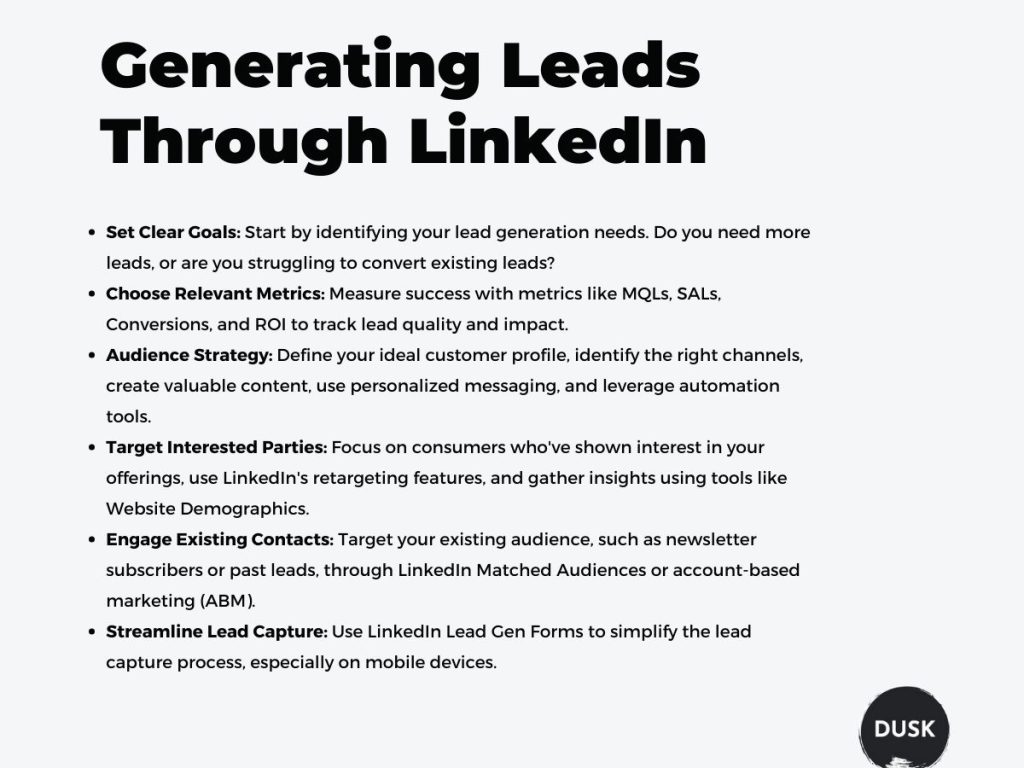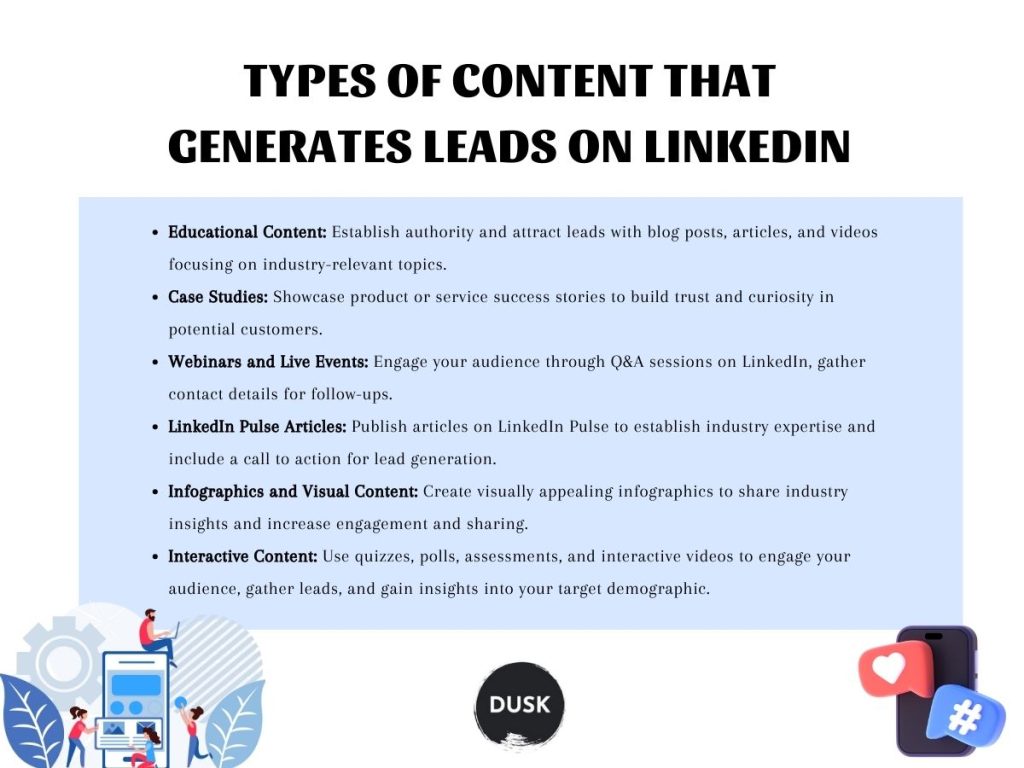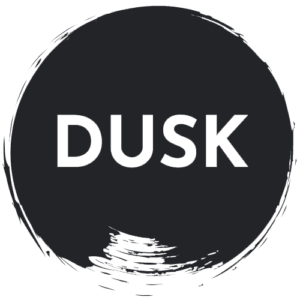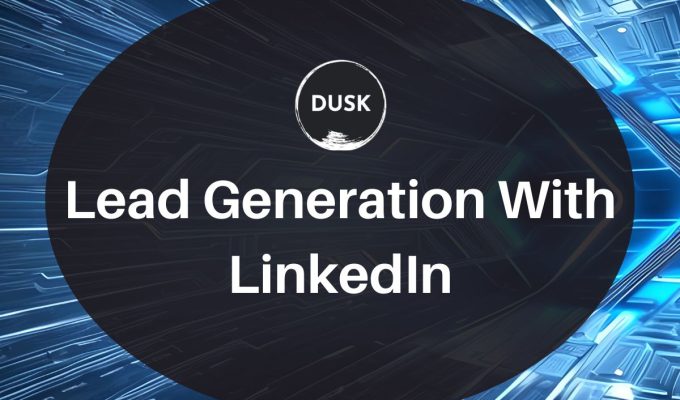The primary goal of lead creation should not be to increase the total number of leads but rather to increase the quality of those leads. Constructing an effective LinkedIn outreach plan requires constant tweaking using methods for locating untapped sales opportunities in order to boost conversion rates.
This article, “Lead Generation With LinkedIn,” will help you in generating more qualified leads for your business, increasing the rate at which you convert them, and therefore proving the value of your marketing efforts. Learn how to link your marketing strategy with the sales team responsible for closing deals and do it more quickly and at a lower cost per lead with our help.
What is Lead Generation?
Lead generation is the process of acquiring and securing business leads. It helps businesses find and engage with customers who are interested in their products and services, making it essential to effective marketing.
Consumers who are a good fit for the ideal client profile and have a higher propensity to become paying customers are what you want to be focusing on. Businesses use LinkedIn marketing campaigns to generate leads, targeting specific job titles, company sizes, or industries.
Businesses may improve their chances of attracting and converting this target demographic by creating content and ad copy that speaks directly to them. The conversion rate is tracked and analyzed during lead generation, allowing them to evaluate their marketing efforts and make changes to improve their strategy.
Generating Leads Through LinkedIn
LinkedIn has emerged as a formidable medium for lead generation in the corporate world. The site’s 700 million-plus user base of professionals represents a massive untapped market for your products and services.
However, in order to reap the full benefits of this medium, a systematic approach to lead creation must be in place.

1. Formulate The Right Goals
Talking to your sales team and sharing your organization’s goals and difficulties is an excellent starting step if you want to boost your company’s lead generation.
Do you have a pressing need for more leads for your sales team? Is growing the sales pipeline a challenge for them? Is it tough for them to reach out to qualified leads? Do you have a lot of unqualified leads that you need to sort through? Do they get impatient because closing a sale takes so long?
If the sales team is unable to reach customers, you should boost the volume of leads and ensure that they are always being refilled. However, if your sales team is already swamped by the volume of leads and struggling to convert them, you should shift your attention to the quality of the leads.
2. Determine The Right Metrics For Your Success
Different criteria for lead generation are needed for various businesses because of their unique needs. Metric names may change from one company to the next.
However, there are essentially four factors to examine when gauging performance in lead creation.
- MQLs, or marketing qualified leads, reveal how many prospects were successfully pursued. If you and your sales team use appropriate criteria to evaluate leads, this metric can be useful. The most prevalent terms are Marketing Accepted Leads or simply Leads.
- SALs or Sales Leads reveal the lowest sales funnel. They reveal the quantity of leads you provide to the sales department. Some companies like to call them Sales Accepted Opportunities, but the premise is the same: leads with relevant sales opportunities that the sales team can close.
- Conversions: This metric pushes you further down the sales funnel by revealing how many initial contacts result in closed deals.
- The Return on Investment (ROI): It tracks the amount of money made as a result of using your leads to make sales.
Your cost per lead (CPL), cost per sales lead (CSL), or cost per conversion (CVC) can then be calculated using these data points. Each marketing touchpoint that contributed to the creation of a lead can be linked back to the revenue generated by your business.
3. Creating a Strategy to Reach Your Target Audience
An important part of being successful in the field of lead generation is learning how to communicate with your intended audience. You may not reach the proper people with your message if you don’t have a well-thought-out plan. How can you tailor a plan to reach your audience and generate qualified leads?
1. Define Your Ideal Customer Profile: Knowing who you want to communicate with is the first step towards actually doing so. Make an ideal customer profile with your target consumers’ demographics, attributes, and pain areas to better understand their needs and customize your content.
2. Research and Identify Relevant Channels: Once you have a clear picture of your ideal consumer, you can begin looking into and determining the channels where they are most engaged. This may involve online and offline communities, events, and social media platforms.
3. Craft Valuable and Relevant Content: Providing relevant and useful information is essential if you want to reach your intended audience. Blog pieces, white papers, case studies, videos, and infographics that address their pain points and give answers can establish you as an industry expert and attract your target audience.
4. Use Personalized Messaging: Personalized emails, social media messages, and direct mail campaigns are essential to deepening audience engagement by adapting communications to target audience segments’ pain points and demands.
5. Leverage Automation Tools: These solutions can schedule and automate marketing operations, track interaction, and nurture prospects, saving time and effort while retaining personalization.
6. Measure and Refine: Use conversion rates, engagement levels, and lead quality to find areas for improvement and optimize your strategy.
4. Address The Right-Interested Parties
Successful lead generation efforts take into account both the information you have about potential consumers and the information they have about your company. If you want to maximize the return on investment from your marketing efforts, you need to focus on reaching consumers at the precise moment they are ready to buy.
To maximize your chances of making a sale, focus first on the consumers who have previously shown interest in your products or services. Since demand is there, you must create leads quickly and efficiently. This audience can be reached via the website retargeting feature of LinkedIn Matched Audiences.
The free Website Demographics tool uses anonymous profile data to provide in-depth insights about your site’s user base. The Insight Tag can also be used to gain access to data about a site’s demographics.
5. Address Potential Customers You Already Know
People who already had contact with your company may be an easy target for lead generation. Customers who are familiar with your products and services are more inclined to engage with your material and advertisements.
You can use LinkedIn Matched Audiences to send targeted messages to the right people by uploading lists of email addresses from your database. These can include newsletter or blog readers, existing customers who may be interested in a new product, or leads who have shown interest but never converted.
Companies that you know will have a need for your solutions will likely have buyers and decision-makers in your target market. With your sales staff, an account-based marketing (ABM) approach can help you gain qualified leads quickly.
6. Make The Most Of Your Targeting With LinkedIn Lead Gen Forms
Generating leads involves luring potential customers into giving you their contact details. Forms are your most valuable source of leads, yet nobody enjoys filling them out, least of all busy decision-makers.
A lower cost per lead can be achieved by making it simpler for these individuals to enter your contact information. Having more qualified leads that make it through the whole lead-generating process is an additional perk.
Therefore, it is imperative to incorporate LinkedIn Lead Gen Forms into your LinkedIn lead creation strategy. Since mobile devices account for 57% of all interactions on LinkedIn, optimizing these shorter, smarter forms for use on these devices makes sense.
Thanks to LinkedIn integration, prospective clients may quickly and easily enter their contact details through their smartphone, with only a few taps of the screen required.
Types of Content That Generates Leads on LinkedIn
LinkedIn is more than just a place to connect with other professionals; it’s also a potent lead-creation tool. There are millions of professionals actively using LinkedIn, which means you have a great chance of reaching your audience and generating qualified leads through the network.
However, not all content is made equal when it comes to lead creation on LinkedIn.

1. Educational Content
Establishing your authority and attracting new leads can be accomplished by providing helpful information to your audience. Blog posts, articles, and videos are just a few examples of the many formats available for educational content.
Prioritize issues that are important to your industry and your audience. You may establish yourself as an authority in your field and generate new leads among those in need of assistance by offering concrete suggestions and instructions.
2. Case Studies
Case studies can effectively demonstrate the success and benefits of your products or services. Prospective customers’ trust and curiosity might be boosted by sharing stories of how your business has helped actual customers overcome obstacles and achieve their goals.
Be sure to highlight relevant metrics and results to prove your solutions’ worth.
3. Webinars and Live Events
Lead generation is facilitated via LinkedIn webinars and live events. During these Q&A sessions, you can interact with the audience in real time to provide answers to their questions and insights into their concerns.
Use LinkedIn to spread the word about your webinars or events and pull in attendees. Make careful to get people’s contact details during the sessions so you may follow up with them afterward.
4. LinkedIn Pulse Articles
LinkedIn members can publish and share long-form pieces via the LinkedIn Pulse content publishing platform. Writing and publishing articles on LinkedIn Pulse is a great way to get your name out there and establish yourself as an industry expert.
Create content that distinguishes itself by providing fresh takes on established topics and actionable advice for readers in your field. You may increase your lead creation by including a call to action at the end of your articles.
5. Infographics and Visual Content
With the right visuals, your LinkedIn posts can go viral. Make use of visual content creation tools to make infographics that show statistical data, trends, or industry insights in a way that is both visually appealing and simple to understand.
Visual content may pique readers’ interest, start meaningful conversations, and propel people to share your work with their own social circles, all of which can expand your audience and generate more leads.
6. Interactive Content
Lead generation on LinkedIn may be made more interesting and engaging by using interactive content like quizzes, polls, assessments, and interactive videos. Develop user-response-based, interactive material that yields unique conclusions or suggestions.
In addition to the leads it produces, this method also provides insight into the tastes and habits of your target demographic.
Leveraging Google My Business to Increase Roofing Leads and Sales
LinkedIn lead generation is difficult without a well-thought-out plan and the appropriate content. You may increase the number of quality leads you receive by using LinkedIn to engage potential customers with relevant and valuable information.
In today’s digital era, it’s not just LinkedIn that’s necessary for a company’s success; a great online presence is also crucial. People are increasingly turning to search engines like Google in order to find nearby businesses like roofing companies. How can you use Google My Business to outrank the competition in search results?






